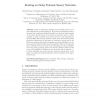Free Online Productivity Tools
i2Speak
i2Symbol
i2OCR
iTex2Img
iWeb2Print
iWeb2Shot
i2Type
iPdf2Split
iPdf2Merge
i2Bopomofo
i2Arabic
i2Style
i2Image
i2PDF
iLatex2Rtf
Sci2ools
118
click to vote
ALGOSENSORS
2009
Springer
2009
Springer
Routing on Delay Tolerant Sensor Networks
Abstract. Delay (or disruption) tolerant sensor networks may be modeled as Markovian evolving graphs [1]. We present experimental evidence showing that considering multiple (possibly not shortest) paths instead of one fixed (greedy) path can decrease the expected time to deliver a packet on such a network by as much as 65 per cent depending on the probability that an edge exists in a given time interval. We provide theoretical justification for this result by studying a special case of the Markovian evolving grid graph. We analyze a natural algorithm for routing on such networks and show that it is possible to improve the expected time of delivery by up to a factor of two depending upon the probability of an edge being up during a time step and the relative positions of the source and destination. Furthermore we show that this is optimal, i.e., no other algorithm can achieve a better expected running time. As an aside, our results give high probability bounds for Knuth’s toilet pap...
ALGOSENSORS 2009 | Expected Time | Markovian Evolving Graphs | Sensor Networks | Tolerant Sensor Networks |
Related Content
| Added | 02 Sep 2010 |
| Updated | 02 Sep 2010 |
| Type | Conference |
| Year | 2009 |
| Where | ALGOSENSORS |
| Authors | Michael Keane, Evangelos Kranakis, Danny Krizanc, Lata Narayanan |
Comments (0)

